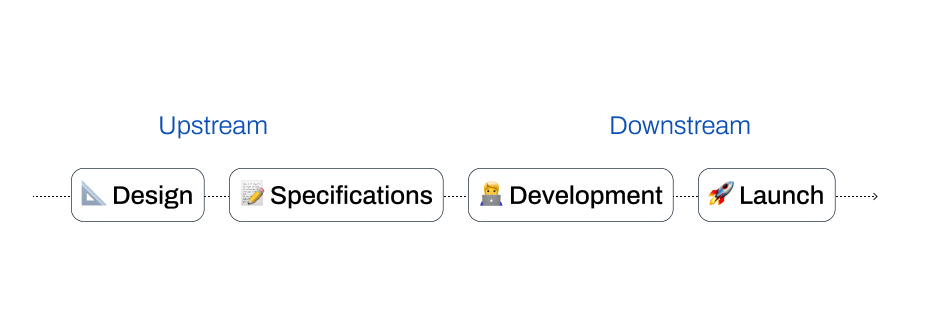New! Live-edit your app's wording with our Chrome extension – now available

For developers
One-click install (no script needed) to release faster and save a lot of time.
For wording owners and reviewers
Translations tailored to your brand and seamless copy edit without the devs defocus.

Published February 27, 2025 in Industry
Choosing the Right Localization Strategy for 2025
Explore how AI and LLMs can achieve professional-quality translations, balancing cost, quality, and time effectively.
In our quest to understand the challenges of software localization, we’ve spoken with over a hundred companies. Through these discussions, two main workflow models have clearly emerged. With the rise of large language models (LLMs), the market is evolving rapidly, and so are localization approaches. Here’s our analysis to help you choose the best localization strategy for 2025!
Two Fundamental Approaches
Software companies typically translate their content using one of two approaches:
- The "upstream" workflow: Translations are done at the design or specification phase.
- The "downstream" workflow: Translations are performed after development.

Key Trend: Since 2024, we’ve seen a significant shift from the "upstream" model to the "downstream" model. Prismy is positioned as a key player in facilitating this transition.

Why Was the "Upstream" Model Dominant Before 2024?
The answer is simple: translation quality.
Technological Limitations
- Machine translation tools like Google Translate or DeepL did not offer sufficient quality.
- Few companies were willing to use these translations in production.
- Translation errors could negatively impact user experience and brand perception.
Dependence on Human Resources
- Achieving acceptable quality required professional translators or native speakers.
- This process was time-consuming, forcing companies to start translations early to avoid delays.
Comparison of Upstream and Downstream Approaches
👍 Advantages of the Upstream Model
The upstream model offers several benefits:
- Smoother development: Developers have all the necessary text from the start, speeding up production.
- Consistent UX/UI: Product designers (UX writers, product managers) maintain control over deployed text.
- Proactive issue detection: Text length, space constraints, or cultural adaptation issues are identified early.
👎 Disadvantages of the Upstream Model
Despite its advantages, this approach has significant limitations:
- Heavy upfront workload: The time spent on translations upfront can be overwhelming, especially beyond 2–3 languages.
- Lack of flexibility: Late modifications require restarting the translation process.
- Missing text issues: Some texts are inevitably forgotten or added late.
- Coordination difficulties: Managing translations alongside development can create priority conflicts.
- Translator errors: Software text includes variables, styles, plurals, etc. Most translators are not trained to handle these, which can lead to bugs if not reviewed by a technical validator.
- Scalability challenges: Beyond three languages, expecting designers or product managers to manage translations effectively becomes unrealistic.
- High translation costs: Professional translators can be expensive.
The "Downstream" Revolution Powered by AI
The rise of advanced language models (LLMs) has changed the game. Companies that once relied on early human translation can now:
- Significantly reduce translation turnaround times.
- Lower costs associated with human translation services.
- Gain agility by adjusting text up until the last moment.
- Obtain high-quality translations automatically. (For more details, check our in-depth article here →)
👍 Advantages of the AI-Powered Downstream Model in 2025
The downstream model offers many benefits, particularly with AI advancements:
- Smoother development: Developers can generate high-quality translations instantly when needed (previously impossible).
- Consistent UX/UI: Product designers maintain control over text by defining AI translation guidelines.
- Resource efficiency: Only the final version of the text is translated.
- Iterative flexibility: Text can be modified until the last minute without affecting development timelines.
- Scalability: Easily add new languages without restarting the development cycle or increasing workload upfront.
👎 Disadvantages of the AI-Powered Downstream Model
This approach also has a few challenges:
- Glossary and translation instructions are essential: However, Prismy’s AI instantly generates translated glossaries and provides instruction templates.
- Late UI constraints: Text length or cultural adaptation issues may only surface late in the process.
How to Choose Between the Two Approaches?
Your choice depends on several factors:
Choose the Upstream Model if:
- Your product targets specific markets requiring deep cultural adaptation.
- Your product support only few languages and you have the time and resources needed to define all translations before developing a feature.
Choose the Downstream Model if:
- You aim for rapid international expansion.
- Your product evolves frequently with regular updates.
- You want to optimize resources and reduce localization costs.
How Prismy Facilitates the Shift to the Downstream Model
Our platform is designed to address the challenges of the downstream workflow:
- Seamless integration with your development pipeline.
- High-quality automatic translation powered by the latest AI advancements.
- Collaboration tools for efficient human review when needed.
- Context-aware translation management to ensure cultural relevance.
Conclusion
The evolution of localization workflows reflects a broader transformation in the tech industry, where agility and efficiency are replacing rigid traditional approaches. By 2025, the downstream model is becoming the new standard, although the upstream approach remains relevant in specific contexts.
Whatever approach you choose, the key is to adopt a localization strategy that aligns with your business goals, available resources, and the expectations of your international users.
Don't miss our industry insights!
Get the latest insights on localization, AI translations, and product updates delivered to your inbox.
No spam, unsubscribe at any time. We respect your privacy.
